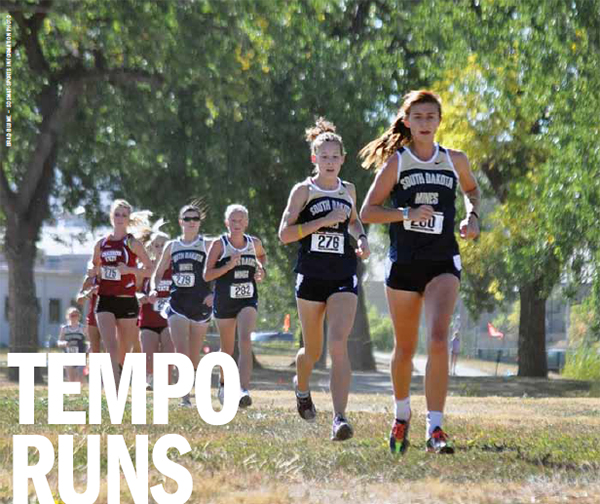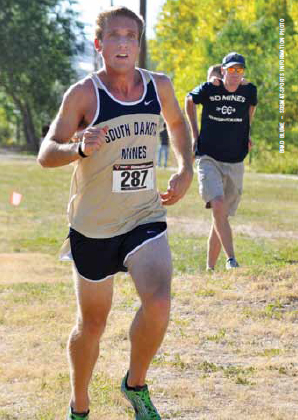|
Tempo Runs: A Staple of Distance Running By: Steve Johnston
 The idea is not a new one. In fact, Jack Daniels, Ph.D., writes about the use of "cruise intervals" in his book Daniels' Running Formula. The basic idea is simple: You can work out longer at your lactate threshold pace by taking short recoveries at a set interval (usually between 1 kilometers and 3 kilometers). Because the recovery interval is so short (around 30 seconds to 1 minute depending on the length of the work bout) heart rate remains elevated and blood lactate levels remain relatively constant. This is a great way to get a little more quality effort in a workout. However, there is one piece that can be missing with this type of training: It's not as mentally challenging for many athletes. Please don't misunderstand what I'm saying. Threshold paced intervals have their place in the training plan, but it should not eliminate the traditional 20-30 (or even 45) minute continuous tempo run. As coaches, we rely heavily on repetition and interval training to improve speed but, athletes teach themselves to run in order to get to the recovery interval. It's a survivalist attitude. The athlete knows that there will be a break soon and that motivates them to push through to the end of the segment. In a continuous tempo run, athletes are forced to apply mental tactics that better emulate racing. They need to be able to refocus when they start to fall off pace. It is a tremendous boost mid-race when you know how to respond as the pain and doubt start to creep into your head. In a continuous tempo run you have two choices when it gets tough: refocus and push through it or quit. Continuous tempo runs provide athletes with the opportunity to experience and combat many of the same physiological and psychological challenges that they will feel in a race. We need to teach our athletes that problems will arise in every race. The way you deal with the problem will determine your ability to achieve the goals for the day. DEALING WITH THE MENTAL BATTLES So, how do you teach your athlete to deal with the internal doubts that creep in? Well, that depends on the athlete but here are a few ideas:
REFOCUS (INTRINSIC) This method is my personal favorite because it can be relatively easy to learn and works extremely well in athletes that are intrinsically motivated. We talk frequently with our athletes (in all events) about the importance of trusting your training. This concept is the foundation for being able to refocus. The athlete needs to acknowledge the doubt, fatigue or other problem and then put it aside and remind himself that he is ready and able to complete the run (or race) because of an the training that has been put in already. CHANGE YOUR FOCUS (EXTRINSIC) This method is better suited for extrinsically motivated athletes. When utilizing this method it is important to make sure you are focusing on something that will still allow you to meet your goals for the workout or race. Running Looney Tunes episodes or a song over and over in your head will not be as beneficial as focusing on staying right on the shoulder of a teammate or a competitor. STEPPING STONES This method works well for intrinsically and extrinsically motivated athletes. In this method the focus becomes setting and achieving smaller goals. This might mean hitting specific split times or getting to the next intersection. With this method it is important to celebrate achieving each goal (without stopping, of course). The nice thing about this method is that it can be used in conjunction with the other two methods. TYPES OF THRESHOLD RUNS This section is by no means all-inclusive but we use a variety of different threshold workouts in our training. From continuous tempo runs to cruise intervals we try to implement a variety of threshold training opportunities in our program to avoid stagnation and to challenge the athlete to grow physically and mentally. Here's a few of the ones we use on a regular basis: CONTINUOUS TEMPOS/PROGRESSIVE TEMPOS: I'm going to "kill two birds with one stone" here. The continuous tempo and the progressive tempo are very similar. In the continuous tempo, your athlete is trying to maintain an average pace without much deviance from that average for the duration of the run. In the progressive tempo, there are two ways of attacking it. The first method, which is very suitable for early fall training, is to build from mid-intensity pace (we usually define this as around 150-160HR for a collegiate runner) to threshold pace (again, I like to use Daniel's VDOT charts to determine this pace). The alternative method, much more suited for late season training, is to average the threshold pace while building up throughout the run. For example, in a 20-minute tempo, a 4:20 miler trying to average 5:15 per mile might run 5:20, 5:17, 5:13 and 5:10 per mile. This results in an average of about 5:15/mile. CRUISE INTERVALS: We've covered these a bit already in this article but the basic concept is shorter threshold based intervals with a short recovery. In our program these usually show up as 2K or 3K intervals with a 1 minute recovery. For us, these usually show up around the start of the indoor track season and are alternated every other week with other threshold work. Intervals could be made as short as 400 meters or as long as 20 minutes if one so desires. HALF AND HALF RUNS: This is the term I use for a run that is set up with half the distance at easy run pace and the other half at threshold or the slightly slower marathon pace. The determination of whether to use threshold or marathon pace is determined by the total length of the run. The key here is that there is no transition between the easy run and the faster portion. That means no drill sets, no rest break, no stopping to stretch out the calves and hamstrings. You hit the halfway point and pick up the pace. Where we have used this the most is as part of the long run. This also means that it's technically not a threshold workout but it can easily be converted into one using shorter distances or times. Instead, I use Daniels' marathon pace and I encourage my athletes to run this section over a hilly or rolling course rather than a flat stretch of road. Typically, we'll see this workout once every three to four weeks but theoretically it could be done more frequently. The catch with this run is that if you have someone with a base pace of 6:15 per mile, this will put their faster section around 5:30 per mile. That means that if they were to go out for a 2 hour long run, they'll run about 9.5 miles at the slower pace and 11 at the faster pace for about a 20-mile day. That's not necessarily a big deal but it does require more recovery time and that is why we space it out so much. PUTTING IT TOGETHER Continuous tempo runs are perfect for summer and early fall training and can work well during the transition period between cross country and the indoor track season. I've found that they can help in the transition between indoor and outdoor track as well. During the winter, especially in the northern part of the country, we will frequently do our tempo runs on the treadmill or along a bike path and changes of pace are difficult with the snow and ice. In each of these times, the athlete's workload is likely to be lower initially and building on a weekly or biweekly basis. This is convenient because it allows us, as coaches, to increase the length of the tempo, and therefore the amount of time that the athlete needs to remain focused, in a controlled manner. When I am working with an athlete who has focus issues, my goals for them in their tempo run and even the route that I send them on will depend on which mental strategy I want them to employ. For example, when applying the refocus method I like to put athletes on the treadmill (and turn the television and music off). I may even have them cover up their screen. Additionally, I will set the pace so they don't have to think about that. This works especially well if you start with a shorter run like a 10 or 15 minute tempo run. If I want to use the "change your focus" or "stepping stones" methods I will usually send them out on the bike path with a group that is slightly faster and have them work on staying with the group for a prescribed amount of time. The key to this is to make sure that they believe they can run with the group in the first place. If you take your No. 10 runner and ask him to stay with your No. 1 runner for an hour there is a good chance he won't last 10 minutes because he's worried about surviving the run and doesn't focus on the actual task of staying on the No. 1 runner's shoulder. Make sure the athlete understands the purpose of the run before starting out. You also have to make sure the athlete is ready for that run mentally. I don't mean are they ready for a tempo. I mean, do they "buy in" to the idea that they have to do this to become a better runner? While the athlete might trust you as a coach, they may not believe that they can complete every workout you give them. With that in mind it is best to start with an easy task such as a 10- or 15-minute tempo run and work your way up. Even a 20-minute tempo run can be daunting if the athlete believes the pace is too tough. As the athlete gets more comfortable, progressive tempo runs can be interspersed to bring up the overall training effort. In a progressive tempo run the pace is increased over the course of the run. Some coaches, myself included, use pre-set intervals of a half-mile, kilometer, or full mile. Other coaches simply give a target pace for the final mile. Both methods have pros and cons. In the former, the athlete knows exactly what they have to do and it is completely controlled from start to finish. The distances used to gauge pace can be tracked using a GPS watch, known checkpoints, or it can be done on the track. The downside is that an athlete can get discouraged if they aren't hitting the pace. The latter method allows the athlete the freedom to determine how fast they go through the run and allows them to have more freedom over their pace. The downside here is that an athlete may not put enough effort into the run until the final mile. WHAT ABOUT THE OTHER STUFF? By now you're probably wondering if any threshold interval-style runs are even going to be done. Absolutely! The key is to bring this work in later, around mid-season. Don't just abandon the threshold training, transition out of it. As you start needing faster paced work, replace the traditional tempo run and the progressive tempo run with the interval-based threshold running. Daniels' cruise intervals fit in well at this point in your training cycle. This can also be a time to introduce continuous effort intervals in which you alternate between faster-paced intervals and recoveries done at your standard training pace. You can use both of these methods to help transition your athletes without having to abandon the strength that will carry them through three seasons of competition. Many coaches believe that you can't have three good seasons of competition. They believe that an athlete must either train through the cross country season to have good indoor track and outdoor track seasons or train through the indoor track season to have good cross country and outdoor track seasons. However, if you carefully analyze your athletes I'd be willing to bet that your strongest athletes tend to perform well in an three seasons. HOW DO I KNOW IT WORKS? We used 7-day microcyles for our training and broke that up into six phases: summer, cross country, transition 1, indoor track, transition 2, and outdoor track. During the summer training and both transitions you will find us using tempo runs and their variations as the primary fast workouts. We also use them early in the cross country season and part of the indoor season. Every season we watch our runners set personal records (PRs) in every event they ran on the track even after a good cross country season. Our upperclassmen show extremely good versatility with this type of training. Many of our middle distance runners are able to race 800 meters through 5,000 meters without seeing much variance between events. Without a doubt, the use of continuous and progressive tempo runs played a role in their success. The use of the mental training strategies discussed earlier were a part of that training. When they were asked to employ these strategies in races, they raced better. Knowing how they were going to cope with the boredom, doubt and fatigue that can set in left them ready and able to continue to push on. We have had athletes that split their mile and 5,000-meter races at their 800-meter and 3,000-meter PRs, respectively. But they weren't distracted by that. Instead they were focused on continuing to push through to the finish. REFERENCES BIO
|







